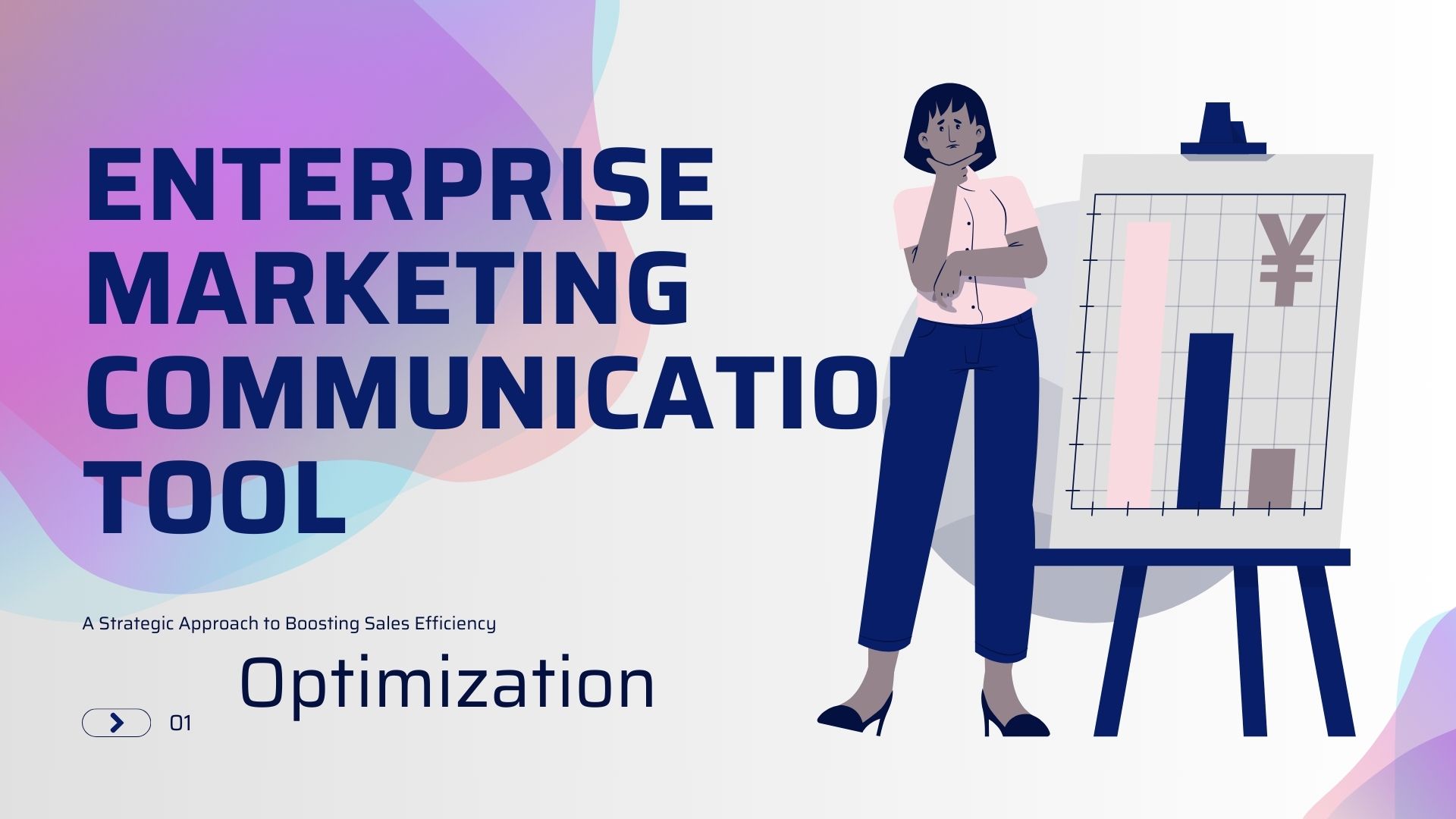Effective communication is crucial for any business, especially in large enterprises where multiple departments and teams must work together. An enterprise marketing communication tool helps streamline these communications, ensuring that all messages are clear and consistent across various channels. With these tools, businesses can tailor their marketing efforts, enhance collaboration, and ultimately improve customer experiences.

These solutions offer features designed to meet the complex needs of big organizations. From project management capabilities to analytics, enterprise marketing communication tools provide a central hub for all marketing activities. Teams can easily access relevant information, track performance metrics, and adapt strategies in real-time, leading to more effective marketing campaigns.
Investing in the right enterprise marketing communication tool is not just about improving internal processes; it’s about aligning marketing efforts with business goals. When communication is handled well, it boosts not only team efficiency but also customer satisfaction, resulting in a stronger brand presence in the marketplace.
Table of Contents
Overview of Enterprise Marketing Communication Tools
Enterprise marketing communication tools play a significant role in connecting businesses with their target audiences. These tools streamline communication, enhance collaboration, and help in managing marketing campaigns more effectively.
Definition and Purpose
Enterprise marketing communication tools refer to specialized software and platforms that assist organizations in managing their marketing communications. They are designed to facilitate the creation, distribution, and monitoring of marketing messages across various channels.
These tools often include features like email marketing automation, social media management, and analytics dashboards. The primary purpose is to align marketing efforts with business objectives, ensuring messages are consistent and reach the intended audience efficiently.
Importance in Business Strategy
Utilizing enterprise marketing communication tools is crucial for a successful business strategy. These tools help companies engage customers by delivering targeted messages, which can lead to increased brand loyalty.
They also provide valuable insights through analytics. By tracking campaign performance and audience engagement, businesses can make informed decisions. This data-driven approach supports continuous improvement and allows teams to adapt their strategies in real-time.
In summary, these tools empower organizations to optimize their marketing efforts and enhance connectivity with their audience.
Key Components
Enterprise marketing communication tools consist of several essential components that work together to improve marketing strategies and facilitate effective communication. Understanding these components is crucial for organizations aiming to enhance their marketing efforts and achieve better results.
Brand Management
Brand management is vital for consistency and recognition across various channels. It involves creating a unified message that reflects the brand’s identity. Effective tools help in developing branding guidelines, ensuring all marketing materials align with the brand image.
These tools can also manage visual assets, including logos and color schemes. By centralizing brand resources, teams can maintain coherence while promoting the brand. Strong brand management improves customer trust and loyalty, which is critical in a competitive market.
Content Creation and Distribution
Content is a key element of marketing communication. Tools for content creation facilitate the development of engaging materials, such as blogs, videos, and social media posts. They often come with templates and editing features that simplify the production process.
Once created, content distribution tools allow marketers to share their materials effectively across multiple channels. Automation features can schedule posts and track their performance to optimize reach. This ensures that the right message reaches the audience at the right time, increasing engagement and visibility.
Data Analytics and Reporting
Data analytics is fundamental for measuring the success of marketing communication efforts. Enterprise marketing tools typically include analytics features that track performance metrics. Key performance indicators (KPIs) such as engagement rates, conversion rates, and return on investment (ROI) are essential for evaluating effectiveness.
Reporting tools provide insights that guide future marketing strategies. Visual dashboards present this data clearly, enabling teams to make data-driven decisions. Understanding analytics helps organizations refine their approaches and improve their marketing outcomes.
Customer Relationship Management
Customer relationship management (CRM) is crucial for building and maintaining strong customer relationships. CRM tools allow organizations to store and manage customer data efficiently. This information helps personalize communication and marketing strategies based on customer preferences.
The integration of CRM with marketing communication tools enhances coordination among marketing, sales, and customer service teams. This comprehensive view of customer interactions improves targeting, engagement, and retention. Effective CRM practices lead to better customer experiences, thereby boosting loyalty and sales.
Integration with Other Systems

Effective enterprise marketing communication tools seamlessly connect with various systems to enhance functionality and streamline processes. These integrations allow businesses to leverage existing data and tools for improved communication and marketing efficiency.
Customer Data Platforms
Customer Data Platforms (CDPs) play a crucial role in enterprise marketing. They collect and unify customer data from different sources, creating a single view of each customer. This comprehensive perspective enables marketers to tailor their messages effectively.
When integrated with an enterprise marketing communication tool, CDPs facilitate personalized marketing, ensuring that communication is relevant. By analyzing customer behavior and preferences, businesses can create targeted campaigns. Furthermore, real-time data updates from the CDP allow marketers to adapt strategies quickly based on current trends.
Sales Enablement Platforms
Sales enablement platforms are designed to support sales teams with resources, tools, and information. Integrating these platforms with marketing communication tools enhances collaboration between marketing and sales departments.
This integration ensures that sales teams are equipped with the latest marketing materials and insights. It helps align messaging across channels and allows for smooth transitions from marketing to sales. With access to shared data, salespersons can engage leads with personalized content, increasing conversion rates.
Marketing Automation Systems
Marketing automation systems automate repetitive tasks such as email campaigns, social media posts, and lead nurturing. Effective integration with an enterprise marketing communication tool can drive efficiency and save time.
Through this integration, marketing teams can schedule campaigns and track performance without manual oversight. Automated data synchronization ensures that metrics are accurate and up-to-date. This allows for informed decision-making and improved accountability across marketing efforts.
In summary, connections with CDPs, sales enablement platforms, and marketing automation systems enhance the capabilities of enterprise marketing communication tools, supporting businesses in achieving their goals more effectively.
Benefits of Using Integrated Communication Tools

Integrated communication tools provide significant advantages for businesses aiming to improve their marketing efforts. These tools help create a more organized approach while enhancing customer engagement and allowing for better measurement and insights.
Streamlined Workflows
Using integrated communication tools simplifies workflows across marketing teams. They consolidate various marketing channels, such as social media, email, and advertising, into one platform. This integration reduces the time spent switching between different tools.
With a unified system, tasks can be assigned and tracked more efficiently. For instance, marketing managers can see the status of campaigns in real-time, leading to quicker decision-making. Improved collaboration among team members also occurs, as everyone has access to the same information.
This seamless process maximizes productivity and ensures that marketing strategies align with business goals. Ultimately, streamlined workflows lead to a more effective use of resources.
Improved Customer Engagement
Integrated communication tools play a critical role in enhancing customer engagement. By delivering consistent messages across various channels, businesses can build a stronger brand identity.
These tools also allow for personalized communication tailored to specific audience segments. For example, targeted email campaigns can reach customers with offers that match their interests. Customers appreciate relevant content, which increases interaction rates.
Additionally, businesses can use feedback mechanisms within these tools to gauge customer responses. Understanding customer needs and preferences leads to better engagement strategies. This two-way communication fuels customer loyalty and drives conversions.
Enhanced Measurement and Insights
Measuring the effectiveness of marketing efforts is crucial for any business. Integrated communication tools provide comprehensive analytics that help track performance across channels.
These tools enable businesses to gather data on key metrics, such as open rates and click-through rates. Detailed insights help identify what strategies are working and which need improvement.
With these metrics, businesses can adjust their campaigns in real-time, leading to more effective marketing spend. They can also compare performance against industry benchmarks for a clear picture of their position in the market.
Effective measurement ensures businesses can make informed decisions, enhancing their overall marketing strategies.
Selection Criteria for Communication Tools

Choosing the right communication tool is essential for business success. Different factors can significantly impact the effectiveness and efficiency of communication within an organization. Key criteria to consider include scalability and flexibility, user-friendly interfaces, customization capabilities, and security and compliance features.
Scalability and Flexibility
Scalability refers to a tool’s ability to grow with a business. As an organization expands, its communication needs often change. A good communication tool should accommodate this growth without requiring a complete system overhaul.
Flexibility is equally important. Teams should be able to adapt the tool to fit various projects or workflows. This might involve adding new users or features as needed. Scalable and flexible tools help ensure long-term usability, making them a prudent investment for businesses of any size.
User-Friendly Interfaces
A user-friendly interface is critical for encouraging team adoption and minimizing training time. Tools with intuitive designs can streamline communication processes. Employees should find it straightforward to navigate through features and functions.
Key aspects of user-friendliness include clear menus and easily accessible support resources. A tool that minimizes unnecessary complexity can reduce frustration and increase productivity. Ultimately, a simple interface helps teams focus on their work rather than struggling with the tool itself.
Customization Capabilities
Customization capabilities allow businesses to tailor communication tools to their specific needs. This could include adjusting settings, integrating with existing software, or modifying visual layouts. Customization enhances user experience and can make the tool more effective for specific projects or team dynamics.
When evaluating customization options, it is essential to consider how easy it is to make changes. A tool that offers extensive customization possibilities may better suit diverse teams and workflows, driving efficiency and satisfaction among users.
Security and Compliance Features
Security and compliance are non-negotiable aspects of communication tools. Organizations must ensure that sensitive information is protected against breaches. This may include using encryption, secure access controls, and regular security updates.
Compliance features are crucial for industries that are subject to regulations. Tools that offer built-in compliance checks can help businesses adhere to necessary standards. Assessing security and compliance features should be a top priority when selecting a communication tool, as failure to protect data can lead to significant legal and financial repercussions.
Implementation Best Practices

Effective implementation of an enterprise marketing communication tool is crucial for maximizing its benefits. Key practices include setting clear objectives, providing comprehensive training for users, and fostering a culture of continuous improvement through feedback.
Establishing Clear Objectives
Setting specific, measurable objectives is the first step in implementing an enterprise marketing communication tool. Organizations should define what they aim to achieve, such as increasing customer engagement or improving campaign efficiency.
A clear roadmap helps teams align their efforts with the objectives identified. To do this, they can create a detailed plan that outlines timelines, key performance indicators (KPIs), and success metrics.
Regularly reviewing these objectives keeps teams focused and allows for adjustments as needed. This proactive approach ensures that all marketing efforts are directed towards achieving the desired outcomes.
Training and Support for Users
Proper training is essential for the successful use of an enterprise marketing communication tool. Users should receive hands-on training that covers the tool’s features and functionalities.
An effective training program may include workshops, tutorials, and ongoing support. Providing access to a knowledge base or help desk allows users to resolve issues quickly.
Engaging users in the training process encourages them to explore the tool’s capabilities fully. Regular refresher courses can also help keep everyone updated on new features and best practices.
Continuous Improvement and Feedback Loops
Establishing feedback loops is vital for continuous improvement when using an enterprise marketing communication tool. Regular assessments help identify areas for enhancement. Stakeholders should be encouraged to provide constructive feedback on their experiences.
This feedback can lead to necessary adjustments in strategies or tool functionalities. Tracking performance metrics over time can reveal trends and effectiveness in communication efforts.
Creating a culture that values ongoing learning and adaptation ensures that the marketing team can respond to challenges effectively.
Challenges and Considerations

Implementing an enterprise marketing communication tool can present various challenges. Organizations must navigate change management, encourage collaboration among departments, and measure the return on investment effectively. Addressing these aspects is crucial for successful integration and optimal use of the tool.
Managing Change in Organizations
Organizations often face resistance when adopting new systems. Change management is essential to help employees adapt to an enterprise marketing communication tool. Effective strategies involve clear communication about the tool’s benefits, training sessions, and support channels.
Leaders should also establish a change management team. This group can address concerns and encourage buy-in. Regular feedback loops are important, allowing employees to voice challenges and suggestions. By taking steps to minimize disruption, organizations can facilitate a smoother transition to a new communication method.
Ensuring Cross-Departmental Collaboration
Using an enterprise marketing communication tool often requires collaboration across departments. This can be challenging if there is a lack of communication between teams. Each department may have different goals and ways of working, which can lead to misunderstandings or an incomplete marketing strategy.
To foster collaboration, organizations should implement regular cross-departmental meetings. These meetings can help align goals and clarify roles. It’s also beneficial to promote a culture of sharing insights and resources. Tools that allow real-time messaging and document sharing can reduce silos and encourage teamwork.
Evaluating Return on Investment
Evaluating the return on investment (ROI) of an enterprise marketing communication tool is crucial for justifying its cost. Organizations should define clear metrics before implementation. Common metrics include improved communication speed, reduced email volume, and enhanced project completion rates.
To assess ROI, it’s important to track performance. Using analytics to measure engagement and productivity can provide relevant data. Comparing these metrics to the costs involved will help determine whether the tool meets its intended goals. Regular reviews will ensure that the tool continues to provide value over time.
Emerging Trends and Future Outlook

The landscape of enterprise marketing communication tools is constantly evolving. Key trends such as Artificial Intelligence, the influence of Big Data, and the focus on privacy and data governance are shaping how organizations communicate effectively.
Artificial Intelligence and Machine Learning
Artificial Intelligence (AI) and Machine Learning (ML) are revolutionizing enterprise marketing communication tools. They enable organizations to automate processes and analyze vast amounts of data for insights. For instance, AI can help in segmenting audiences by their behaviors and preferences.
This allows businesses to tailor their messages, leading to higher engagement rates. Additionally, chatbots powered by AI enhance customer interactions by providing immediate responses to inquiries. As these technologies evolve, they will continue to play a pivotal role in optimizing communication strategies.
The Role of Big Data
Big Data is crucial for enhancing enterprise marketing communication. By harnessing data from multiple sources, organizations can gain a comprehensive view of their audience. This insight helps in creating targeted campaigns that resonate with customers.
For example, analyzing consumer behavior patterns allows companies to predict future trends and adapt their messaging accordingly. Effective use of Big Data ensures that marketing efforts are not only efficient but also relevant, helping brands to stand out in a crowded market.
Privacy and Data Governance
With the rise of digital communication, privacy and data governance have become significant concerns. Organizations must comply with regulations like GDPR to protect consumer data.
Clear policies and practices around data handling build trust and enhance brand reputation. Enterprise marketing communication tools are increasingly incorporating features that prioritize user privacy, ensuring that customer information is managed securely. This trend will continue as consumers demand greater transparency regarding their data.




